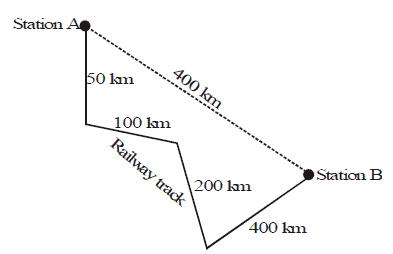BASIC
Scalar quantities
A scalar quantity is a quantity which is defined by only magnitude. Some examples of scalar quantities are Mass, Charge, Pressure, etc.
Vector quantities
Vector quantities are those which have both magnitude and direction and obey vector laws of addition. Some examples of vectors are displacement, velocity, force, etc.
MOTION
Movement of any object from one position to another position with respect to the observer is called as Motion.
Distance
Distance is the actual path travelled by an object from its initial position to final position. It is a scalar quantity.
Displacement
Displacement of object is equal to the length of the shortest path between the final and the initial points. Its direction is from the initial point to the final point. It is a vector quantity.
example

the 400 km. is displacement while rest of the path is distance covered.
Speed
Speed is rate of change of distance,it is the measurement of how fast or slow objects move, can be given by formula,
It is a scalar quantity.


Scalar quantities
A scalar quantity is a quantity which is defined by only magnitude. Some examples of scalar quantities are Mass, Charge, Pressure, etc.
Vector quantities
Vector quantities are those which have both magnitude and direction and obey vector laws of addition. Some examples of vectors are displacement, velocity, force, etc.
Scalars and Vectors
Following are some differences listed between scalars and vectors.
| S.No. | Scalars | Vectors |
| 1. | Have only magnitude | Have both magnitude and direction |
| 2. | Algebra: Same as real numbers | Algebra: Follow vector laws of addition |
| 3. | Examples: Mass, charge, etc | Examples: velocity, force, electric field. etc. |
MOTION
Movement of any object from one position to another position with respect to the observer is called as Motion.
Distance
Distance is the actual path travelled by an object from its initial position to final position. It is a scalar quantity.
Displacement
Displacement of object is equal to the length of the shortest path between the final and the initial points. Its direction is from the initial point to the final point. It is a vector quantity.
example

the 400 km. is displacement while rest of the path is distance covered.
| Differentiating Property | Distance | Displacement | |
| 1 | Definition | The complete length of the path between any two points is called distance. | Displacement is the direct length between any two points when measured along the minimum path between them. |
| 2 | Denotation | d | s |
| 3 | Direction Consideration | To calculate distance, direction is not considered. | To calculate displacement, direction is taken into consideration. |
| 4 | Quantity | Distance is a scalar quantity as it only depends upon the magnitude and not the direction. | Displacement is a vector quantity as it depends upon both magnitude and direction. |
Speed
Speed is rate of change of distance,it is the measurement of how fast or slow objects move, can be given by formula,
- Average speed: For non-uniform motion, the average speed of an object is obtained by dividing the total distance travelled by an object by the total time taken.

Velocity
the distance travelled by an object per unit time inn given direction
Velocity is a vector quantity. SI unit of velocity is metre/sec.
Velocity = Displacement of Object / Time Taken
Average velocity: It is given by the arithmetic mean of initial velocity and final velocity for a given period of time.
Instantaneous Speed and Velocity
Instantaneous speed is the speed of an object at a particular moment (instant) in time.
Instantaneous velocity is the velocity of an object in motion at a specific point in time.
Differentiating Property
|
Velocity
|
Speed
| |
1
|
Definition
|
|
|
2
|
Type of quantity
|
|
|
3
|
Magnitude
|
|
|
4
|
Change of direction
|
|
|
5
|
Interrelation
|
|
|
Acceleration (a):
- The rate of change of velocity is termed as acceleration.
- It is represented as:

- Its SI unit is metre/seccond2 (m/s2).
- It is a vector quantity.
- The acceleration is taken to be positive if it is in the direction of velocity and negative when it is opposite to the direction of velocity.
- Negative acceleration is also named as retardation or deacceleration.
- An object moving on a circular path though with uniform speed, is always said to be accelerated as it changes its direction every moment.
- Uniform acceleration: When velocity of body changes by equal amounts in equal time intervals, acceleration is said to be uniform. For example: Motion of a freely falling ball.
- Non - uniform acceleration: When velocity of body changes by unequal amounts in equal intervals if time, acceleration is said to be non - uniform. For example: Motion of car.
- Acceleration due to GravityAcceleration due to gravity is the acceleration of a body falling freely under the influence of the Earth's gravitational pull at sea level. It is approximately equal to . Its measured value varies slightly with latitude(due to rotation of earth) and longitude(due to non-spherical shape of earth) and also with depth and height from the earth's surface.
A
Comments
Post a Comment
if you have any doubts. please let me know.